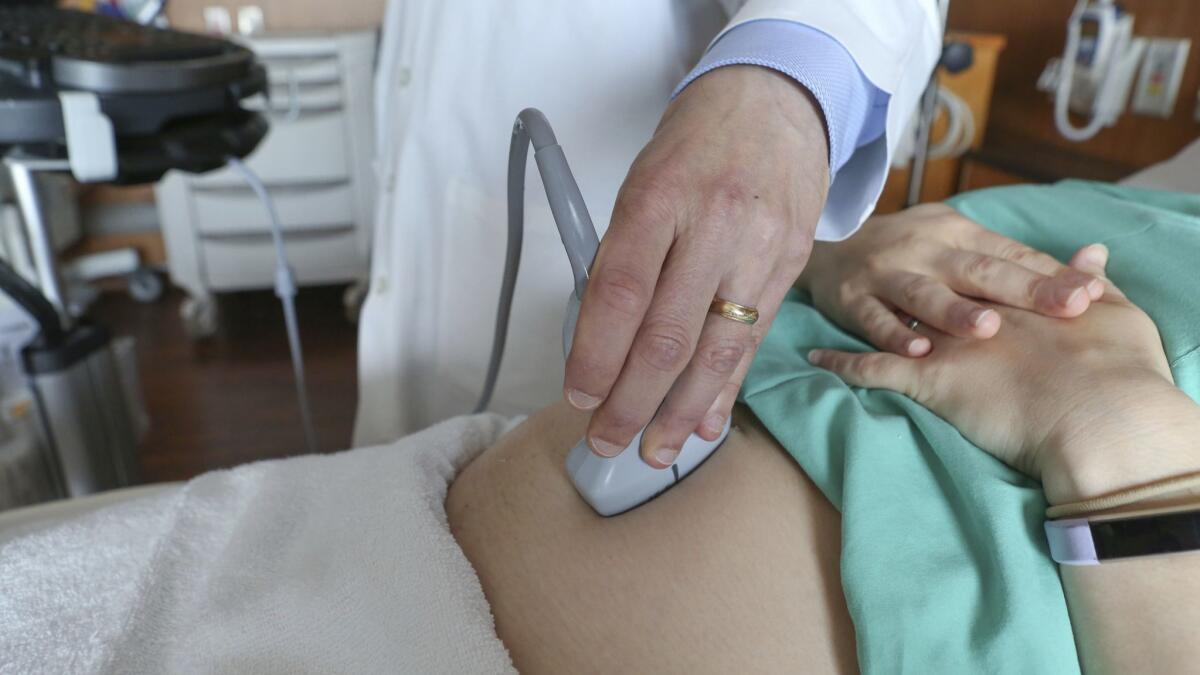1,306 U.S. infants were born with syphilis in 2018, even though itâs easy to prevent

One of the nationâs most preventable diseases is killing newborns in ever-increasing numbers.
Nationwide, 1,306 infants acquired syphilis from their mother in 2018, a 40% rise over 2017, according to federal data released Tuesday. Seventy-eight of those babies were stillborn, and 16 died after birth.
In California, cases of congenital syphilis â the term used when the infection is passed to a baby during pregnancy â continued a stark seven-year climb. There were 332 cases in the state in 2018, an 18.1% increase from 2017, according to the federal data.
Only Texas, Nevada, Louisiana and Arizona had congenital syphilis rates higher than Californiaâs, which was 67.9 cases per 100,000 live births. (The highest rate was in Texas, where there were 92.2 cases per 100,000 live births.) Combined, those five states made up nearly two-thirds of total cases, although all but 17 states saw increases in their congenital syphilis rates.
The state-by-state numbers were released as part of a broader report from the Centers for Disease Control and Prevention tracking trends in sexually transmitted diseases. Nationwide cases of syphilis, gonorrhea and chlamydia combined reached an all-time high in 2018. Cases of the most infectious stage of syphilis rose 14% to more than 35,000 cases; gonorrhea increased 5% to more than 580,000 cases; and chlamydia increased 3% to more than 1.7 million cases.
For veteran public health workers, the upward trend in congenital syphilis numbers is particularly disturbing because the condition is so easy to prevent. Blood tests can identify infection in pregnant people. The treatment is relatively simple and effective. When caught during pregnancy, transmission to the baby can generally be stopped.
âWhen we see a case of congenital syphilis, it is a hallmark of a health system and a healthcare failure,â said Virginia Bowen, an epidemiologist with the CDC and an author of the new report.
It takes just a few shots of antibiotics to prevent transmitting syphilis during pregnancy. Left untreated, Treponema pallidum, the corkscrew-shaped organism that causes syphilis, can wiggle its way through the placenta and into a fetus. Once there, it can multiply furiously, invading every part of the body.
The effects can be devastating. Dr. Philip Cheng is a neonatologist at St. Josephâs Medical Center in Stockton. The brain of one of his patients didnât develop properly, and the baby died shortly after birth. Other young patients survive but battle blood abnormalities, bone deformities and organ damage. Congenital syphilis can cause blindness and excruciating pain.
Public health departments across Californiaâs Central Valley, a largely rural expanse, report similar experiences. In 2018, syphilis, gonorrhea and chlamydia reached their highest levels in 30 years, according to state figures released Tuesday. The California Department of Public Health attributed 22 stillbirths or neonatal deaths to congenital syphilis.
For the last several years, Fresno County, which had 60 cases of congenital syphilis in 2017, had the highest rate in California. In 2018, Fresno fell to fourth, behind Yuba, Kern and San Joaquin counties. But the epidemic is far from under control.
âI couldnât even tell you how soon I think weâre going to see a decrease,â said Jena Adams, who oversees HIV and STD programs for Fresno County.
Syphilis was once a prolific and widely feared STD. But by the 1940s, penicillin was found to have a near-perfect cure rate for the disease. By 2000, syphilis rates were so low in the U.S. that the federal government launched a plan to eliminate the disease. Today, that goal is a distant memory.
Health departments once tracked down every person who tested positive for chlamydia, gonorrhea or syphilis, to make sure they and their partners got treatment. With limited funds and climbing caseloads, many states now devote resources only to tracking syphilis. The caseloads are so high in some California counties that they track only women of childbearing age or just pregnant women.
âA lot of the funding for day-to-day public health work isnât there,â said Dr. Jeffrey Klausner, a professor at UCLA who ran San Franciscoâs STD program for more than a decade.
The bulk of STD prevention funding is appropriated by Congress to the CDC, which passes it on to states. That funding has been largely flat since 2003, according to data from the National Coalition of STD Directors, which represents health departments across the country. Take into account inflation and the growing caseloads, and the money is spread thinner. âIt takes money, it takes training, it takes resources,â Klausner said, âand policymakers have just not prioritized that.â
San Joaquin County health officials have reorganized their department and applied for grants to increase the number of investigators available as congenital syphilis has spiked, said Hemal Parikh, county coordinator for STD control. But even with new hires and cutting back to tracking only women of childbearing age with syphilis, an investigator can have anywhere from 20 to 30 open cases at a time. In other counties, the caseload can be double that.
In 2018, Jennifer Wagman, a UCLA professor who studies infectious diseases and gender inequality, was part of a group that received CDC funding to look into what is causing the spike in congenital syphilis in Californiaâs Central Valley.
Wagman said that, after years of studying health systems in other countries, she was shocked to see how much basic public health infrastructure has crumbled in California. In many parts of the Central Valley, county walk-in clinics that tested for and treated STDs were shuttered in the wake of the recession. That left few places for drop-in care, and investigators with no place to take someone for immediate treatment.
The most challenging cases in California are wrapped up with the stateâs growing housing crisis and a methamphetamine epidemic with few treatment options. Women who are homeless often have unreliable contact information and are unlikely to have a primary care doctor. That makes them tough to track down to give a positive diagnosis, or to follow up on a treatment plan.
Louisiana had the highest rate of congenital syphilis in the country for several years â until 2018, when it dropped 22% to 72.8 cases per 100,00 live births. Louisiana now ranks behind Texas and Nevada. (The Silver State had 85.5 cases per 100,000 live births last year.)
The drop in Louisiana is the direct result of $550 million in temporary supplemental funding that the CDC gave the state to combat the epidemic, said Chaquetta Johnson, deputy director of operations for the stateâs STD/HIV/hepatitis program. The money helped bolster the stateâs lagging public health infrastructure. It was used to hire two case managers and a nurse educator, create a program for in-home treatment and improve data systems to track cases, among other things.
In California, more than 40% of pregnant people with syphilis passed it on to their baby in 2016, the most recent year for which data is available. Gov. Gavin Newsom made additional funding available this year, but itâs a âdrop in the bucket,â said Sergio Morales of Essential Access Health, a nonprofit that focuses on sexual and reproductive health and is working with Kern County on congenital syphilis.
âWe are seeing the results of years of inaction and a lack of prioritization of STD prevention,â he said, âand weâre now paying the price.â
Barry-Jester is a correspondent for Kaiser Health News, an editorially independent publication of the Kaiser Family Foundation.






